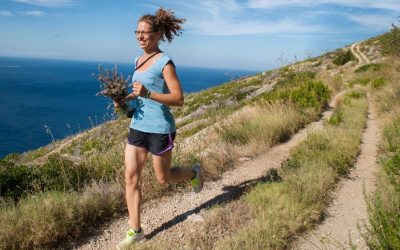If you struggle with tightness in your calves, ankles, or Achilles, this stretch is for you!
As a Physical Therapist, I see runners doing calf stretches that aren’t helping them far too often.
Many runners think they’re getting a good stretch when they wedge their heels into the wall or drop them off the edge of a step.
The problem is these stretches are static. You want to be doing dynamic movements to access all parts of your calf muscle.
The calf gets loaded when you run, so you need to stretch it properly if you want to keep running injury-free.
Watch the video to learn the best way to stretch your calves!
Why Do This Stretch?
It’s especially important to stretch your calves as you change your run form.
Most runners are heel strikers, which means they run with their heels hitting the ground first. This is a terrible way to run because you’re catching yourself on your bones instead of your muscles.
Many runners are also toe strikers, which isn’t any better. When you come down on the front of your toe, you will overload your calf and cause injuries.
The best way to run is by landing on your midfoot. This will load your calf, hamstrings, quads, and glutes. You will then catch yourself on these strong muscle groups instead of your bones.
Since your calves will get loaded when you run midfoot, you must be sure to stretch them properly.
How to Do It
There are three variations on this calf stretch that I love to use with my runners.
For the first variation, put yourself in a stride position with both hands on the wall. Then glide forward and back for 20 reps.
You will feel the stretch in whatever part of the calf is tightest.
Get in the same stride position for the second variation but rock your hips from side to side instead. Do 20 reps, 10 on each side.
You should feel the stretch hitting different parts of the calf.
For the third variation, get into the same stride position but bend your back knee. This will go right after the soleus, which is a deep muscle in the calf.
Be sure to keep your back heel down for all three variations.
Key Takeaway
If you want to run faster and injury-free, you need to stretch your calf muscles properly.
This means doing dynamic stretches that activate the muscle in multiple directions.
It’s especially important to stretch your calves if you’re running correctly on your midfoot.
If you want help transitioning to midfoot running, check out our Free Guide to Improving Run Form!
Overhaul your running technique for more speed and fewer injuries!
Ready to Improve Your Run Form?
Download Steve Gonser’s FREE run form guide!
You will learn:
- How to find your midfoot – and it’s not from running on your toes or avoiding your heel
- What you should feel and expect when changing your run form
- #1 stretch to ease tension in your lower legs to transition your stride safely
- The best glute exercise to support your new run form
- Top 3 benefits to learning a proper midfoot strike




